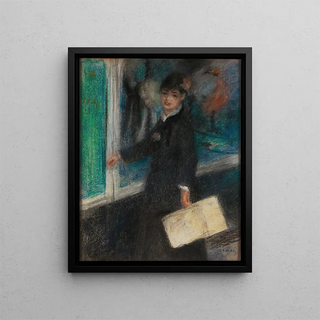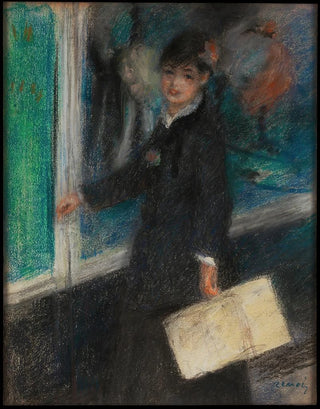Art print | The Milliner - Pierre-Auguste Renoir


View from behind

Frame (optional)
In the vibrant world of Impressionism, one artwork stands out for its elegance and timeless charm: "The Milliner" by Pierre-Auguste Renoir. This canvas, painted in 1876, evokes not only the beauty of a woman in deep contemplation but also the delicate atmosphere of an era where fashion and art intertwined harmoniously. Renoir, through this piece, transports us to a suspended moment, where the lightness of fabrics and the softness of colors combine to capture the very essence of femininity. The art print of this work allows appreciation of the finesse of its execution and the emotion it conveys, while offering a new perspective on the artist's talent.
Style and uniqueness of the work
"The Milliner" is characterized by an Impressionist style that defines Renoir's reputation. The brushstrokes, fluid and light, breathe vibrant life into the canvas. The light, omnipresent, plays a fundamental role, illuminating the milliner's face and creating a play of shadows that emphasizes the scene's three-dimensionality. The colors, warm and delicate, blend with such harmony that they almost seem to vibrate. The woman depicted, dressed in an elegant gown, embodies a certain grace, while her contemplative gaze invites the viewer to ponder her thoughts. This work does not merely depict a female figure; it also evokes an atmosphere, a lifestyle, that of Parisian bourgeoisie at the end of the 19th century, where fashion became an art in its own right.
The artist and his influence
Pierre-Auguste Renoir, one of the masters of Impressionism, marked art history with his ability to capture the beauty of simple moments. Influenced by the artistic currents of his time, he developed a personal style that combines sensitivity and technique. His work, rich in colors and emotions, reflects an optimistic vision of life. Renoir also played a key role in the evolution of painting, moving away from academic conventions to explore new forms of expression. His influence is felt far beyond

Matte finish

View from behind

Frame (optional)
In the vibrant world of Impressionism, one artwork stands out for its elegance and timeless charm: "The Milliner" by Pierre-Auguste Renoir. This canvas, painted in 1876, evokes not only the beauty of a woman in deep contemplation but also the delicate atmosphere of an era where fashion and art intertwined harmoniously. Renoir, through this piece, transports us to a suspended moment, where the lightness of fabrics and the softness of colors combine to capture the very essence of femininity. The art print of this work allows appreciation of the finesse of its execution and the emotion it conveys, while offering a new perspective on the artist's talent.
Style and uniqueness of the work
"The Milliner" is characterized by an Impressionist style that defines Renoir's reputation. The brushstrokes, fluid and light, breathe vibrant life into the canvas. The light, omnipresent, plays a fundamental role, illuminating the milliner's face and creating a play of shadows that emphasizes the scene's three-dimensionality. The colors, warm and delicate, blend with such harmony that they almost seem to vibrate. The woman depicted, dressed in an elegant gown, embodies a certain grace, while her contemplative gaze invites the viewer to ponder her thoughts. This work does not merely depict a female figure; it also evokes an atmosphere, a lifestyle, that of Parisian bourgeoisie at the end of the 19th century, where fashion became an art in its own right.
The artist and his influence
Pierre-Auguste Renoir, one of the masters of Impressionism, marked art history with his ability to capture the beauty of simple moments. Influenced by the artistic currents of his time, he developed a personal style that combines sensitivity and technique. His work, rich in colors and emotions, reflects an optimistic vision of life. Renoir also played a key role in the evolution of painting, moving away from academic conventions to explore new forms of expression. His influence is felt far beyond






